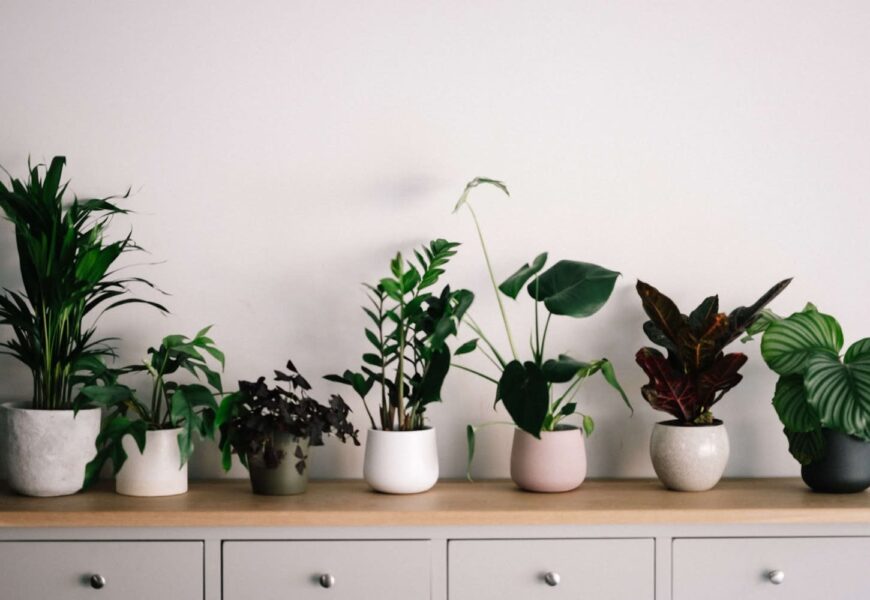Adding plants to your home is a simple yet powerful way to infuse your living space with the beauty and tranquility of nature. Beyond their aesthetic appeal, houseplants offer a range of benefits, from improving air quality to boosting your mood. Here’s why you should consider incorporating plants into your home décor and how to get started.
The Benefits of Houseplants
- Improved Air Quality: Plants are natural air purifiers. They absorb carbon dioxide and release oxygen, and some species can even filter out harmful toxins from the air. Common air-purifying plants include the snake plant, spider plant, and peace lily.
- Boosted Mood and Productivity: Being around greenery has been shown to reduce stress and enhance mood. Plants can create a calming environment, making them perfect for home offices and living areas. Studies have also found that having plants around can improve concentration and productivity.
- Increased Humidity: Plants release moisture into the air through a process called transpiration. This can help maintain indoor humidity levels, which is beneficial in dry climates or during winter months when indoor air tends to be drier.
- Aesthetic Appeal: Plants add color, texture, and life to any room. They can complement various interior design styles, from modern to rustic, and serve as beautiful focal points or accents.
- Connection to Nature: Incorporating plants into your home décor helps create a connection to the natural world, promoting a sense of well-being and harmony. This biophilic design approach can make your home feel more inviting and peaceful.
Choosing the Right Plants for Your Home
- Assess Your Space: Consider the lighting conditions and available space in your home. Some plants thrive in bright, direct sunlight, while others prefer low-light environments. Additionally, think about the size of the plant and where you plan to place it.
- Consider Maintenance: Choose plants that match your level of gardening expertise and the amount of time you can dedicate to their care. Some plants require frequent watering and attention, while others are more low-maintenance.
- Pet-Friendly Options: If you have pets, be mindful of plant toxicity. Some common houseplants can be harmful to pets if ingested. Opt for pet-safe plants like spider plants, Boston ferns, and areca palms.
- Variety: Incorporate a mix of plant types to add visual interest and diversity. Combine leafy greens with flowering plants, succulents, and even small trees to create a dynamic and engaging indoor garden.
Easy-Care Houseplants for Beginners
- Snake Plant (Sansevieria): Known for its resilience, the snake plant can tolerate low light and infrequent watering. Its tall, upright leaves make it a striking addition to any room.
- Pothos (Epipremnum aureum): Pothos is a versatile plant that can thrive in various lighting conditions. It’s also known for its air-purifying qualities and is easy to propagate.
- Spider Plant (Chlorophytum comosum): Spider plants are hardy and adaptable, making them perfect for beginners. They produce “spiderettes” or baby plants that can be easily repotted.
- ZZ Plant (Zamioculcas zamiifolia): The ZZ plant is almost indestructible, thriving in low light and requiring minimal watering. Its glossy, dark green leaves add a touch of elegance to any space.
- Aloe Vera: Aloe vera is not only easy to care for but also has medicinal properties. It prefers bright, indirect light and minimal watering.
Tips for Incorporating Plants into Your Home
- Group Plants Together: Create a lush, green corner by grouping several plants of varying heights and textures. This can make a bold statement and enhance the overall aesthetic of the room.
- Use Stylish Planters: Choose planters that complement your décor. From modern ceramic pots to rustic baskets, the right planter can enhance the look of your plants and add to the room’s design.
- Vertical Gardens: If you’re short on floor space, consider vertical gardening options like hanging planters, wall-mounted pots, or shelving units. These can add greenery without taking up valuable surface area.
- Rotate Plants: To ensure even growth and prevent plants from leaning towards the light, rotate them regularly. This also allows you to change up your décor periodically.
- Integrate Plants into Functional Spaces: Place plants in areas where you spend a lot of time, such as your home office, kitchen, or bathroom. This can improve air quality and create a more pleasant environment.
Conclusion
Incorporating plants into your home is an excellent way to bring the benefits of nature indoors. From improving air quality to enhancing your mood and adding aesthetic appeal, houseplants are a versatile and valuable addition to any living space. Start with a few easy-care plants and experiment with different arrangements to create your own indoor oasis. With a little care and attention, you can enjoy the beauty and benefits of plants all year round.











